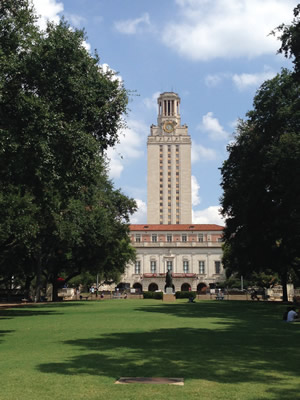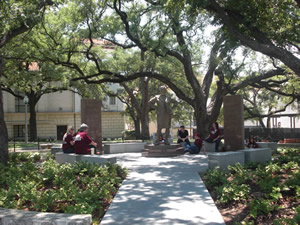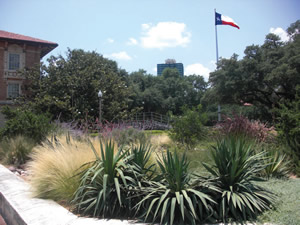Maintaining the Green

PHOTOS COURTESY OF JOHN BURNS
What does sustainable landscaping mean today? That’s the question we posed to John Burns, CGM, manager of Landscape Services at The University of Texas at Austin. Burns, who has been with the university — which is a public research university and the flagship institution of The University of Texas System — for 35 years, has witnessed firsthand the changes in sustainable landscaping through the years. His expertise comes from his experience, as well as his involvement with the Baltimore-based Professional Grounds Management Society (PGMS, www.pgms.org), of which he is currently president.
CPM: How is sustainable landscaping different from landscaping?
BURNS: Sustainable landscaping is so much more than going to a big-box store and buying whatever looks nice. It is a thought and planning process. It requires thinking about the needs of the plants and what is required to keep them healthy and thriving. Oftentimes, this leads to using native plants that are well adapted to your climate and growing conditions. The benefit is that these plants require less input from chemicals, such as pesticides, fungicides and fertilizers.
As an example, years ago, we planted azaleas on campus. They were beautiful and helped us create a beautiful campus landscape, but they required huge amounts of water and great effort to keep or lower the soil pH (alkalinity). For us, the use of azaleas did not equal sustainable landscaping. We don’t have the staff or budget today to water and maintain them, especially with the drought situation here in Texas. We took them out, choosing to be better stewards of our environment and available funds.
CPM: What does sustainable landscaping mean today?
BURNS: Sustainable landscaping is about being good stewards of everything required to keep the environment healthy and aesthetically pleasing. A good example, as I already mentioned, is using native plants, which require little care.
CPM: How does sustainable landscaping benefit campuses?
BURNS: Sustainable landscapes reduce or conserve natural resources and maintenance inputs, which result in dollar savings. One thing that is really important to us at the University of Texas is reducing chemical use. Here are two examples of how we’re doing that.
First, we have a commitment to an organic fertilizer program, which we are excited about. We do not use any synthetic fertilizer at all. That’s a chemical reduction that has the added benefit of helping build soil. We are not killing the microorganisms in the soil, but allowing them to thrive to help plant growth.
Second, we have an integrated pest management program, which also reduces chemical input. Here again, using native plant materials reduces the need for pesticides, which makes the campus a safer environment for everybody in that we aren’t constantly spraying for insects or diseases.
We do have fire ants and we treat for them, but we use the least toxic effective method. There are a lot of things that are less toxic but they aren’t as effective. The result is a healthier ecosystem because we’re not killing beneficial insects or organisms.
CPM: For campus administrators desiring to begin sustainable landscaping programs, what are the first steps?
BURNS: I think the first thing that administrators must understand and accept is that a sustainable landscape will more than likely not have the same appearance that they are used to seeing. Depending on the area of the country, it might be a major difference. Once this is understood and accepted, new standards — as well as funding for landscape conversions — must be put in place.
CPM: What are the first few techniques administrators should implement, and why?
BURNS: First, use native or adapted/adaptive plant materials. Second, consider improving your irrigation systems to ensure they are effective and closely monitored to not waste water. Third, the new landscape should be designed with sustainability in mind.
CPM: What are three of your favorite sustainable landscaping techniques?
BURNS: The first is using native plants to create a more natural landscape, which improves the ecosystem. The second is building good, healthy soils by using organic fertilizers, compost and other organic soil additives to build organic matter and microbial activity, thus reducing the need for chemical inputs and reducing water use. The third is reducing water use by using water more efficiently. They’re all tied together: you can’t do one without the others.


PHOTOS COURTESY OF JOHN BURNS
WHAT GROWS HERE? The main goals of sustainable landscape design are to conserve water and energy, reduce waste and decrease runoff. In order to achieve these goals water should be treated as a resource, soil should be valued, existing plants evaluated and material resources conserved. A sustainable landscaping approach would be to assess the existing plant material on and around your campus and preserve, as well as add, native plants. Invasive, non-native plants should be removed and replaced with more appropriate choices. “Right plant, right place” is a popular saying that should guide your plant selection. The results will be attractive and easy-to-maintain outdoor spaces.
Actually we are taking all of this to a new level on our campus. We have developed a new landscape campus master plan. Part of the master plan includes converting some areas from turf grass to meadows and savannahs. Of course, this will bring new challenges in learning how to properly manage them and educating our constituents about the intended appearances and benefits. The bottom line is that it’s going to be a major change in the appearance of our campus.
And, of course, there are always more techniques. For example, we have some rainwater collection systems, and we will have more in the future because it’s a state mandate that all of our buildings have them. We’re struggling a bit on the collection side in that, when rainwater is collected from a roof, there’s always the chance there will be contaminants in it, so we have to do some filtering and flushing. We do water testing to make sure it’s safe to put out.
Even with filtering, flushing and testing, we believe rainwater collection is cost effective. But note that a lot of what we do with sustainability is not because it’s cost effective but because it’s the right thing to do. In Texas, water is key. We can’t have sustainable landscaping without effective water use.
CPM: What do campus administrators most need to know on their quest for sustainable landscaping?
BURNS: That it takes commitment and investment. It’s a long process to convert existing landscapes to more sustainable solutions.
Another thing to consider, if you don’t have an in-house landscape architect, is that you have to be careful in choosing a firm for its ability to work through the process. You’ll want to be sure to provide the firm with your expectations and work closely with the team to be sure they’re providing sustainable designs.
CPM: What unique considerations do campuses have regarding sustainable landscaping that other businesses/industries perhaps don’t?
BURNS: Most businesses or industrial campuses probably don’t have to provide outdoor event space. In our case we have 50,000-plus students in a 450-acre space. We have to provide not just event space, but space for that number of students to enjoy the campus. So turf and open spaces that are useable on a day-to-day basis and are always aesthetically pleasing become important.
This article originally appeared in the issue of .